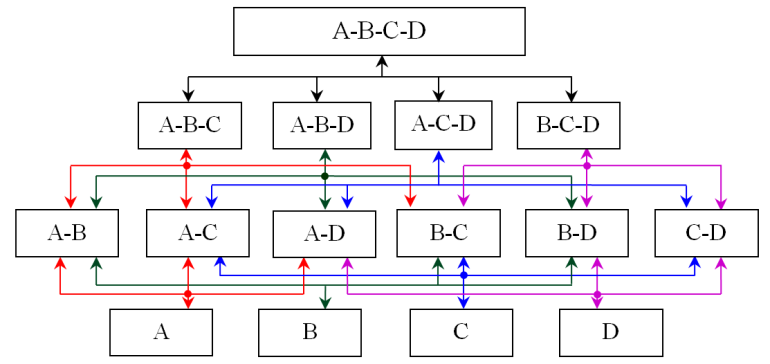download the thermodynamic database manual
download the molar volume database manual
download the mobility database manual
Emerged in the late 1950s, the primary goal of the CALPHAD (an acronym for CALculation of PHAse Diagram) approach is to calculate phase equilibria and thermodynamic properties of complex multi-component, multi-phase systems. The essence of this approach is to obtain a set of self-consistent Gibbs energy functions (referred to as a thermodynamic description or a thermodynamic database) for all the phases in a system (usually a binary or ternary) in terms of known thermodynamic and phase equilibrium data of the system. By self-consistent, it means that the separately measured phase diagrams and thermodynamic properties can be represented by the same thermodynamic description. Moreover, it can be used to calculate any thermodynamic and phase equilibrium related properties in the same system. More importantly, a multi-component thermodynamic database can be built up through those of the constituent lower order systems using geometric models, and such a database enables us to calculate phase diagrams of the multi-component systems that are experimentally unavailable.
In recent years, the CALPHAD approach has been used to describe phase properties beyond thermodynamics and phase equilibria. Property databases, such as the mobility database and molar volume database, have been developed using a similar manner as that of a thermodynamic database. Constructing a database for a multi-component system always starts from the constituent subsystems. The below figure demonstrates the concept of building a database for a quaternary system through its constituent unary, binary and ternary systems.

A multi-component system is built up from the constituent unary, binary, ternary, quaternary, and so on subsystems. A system with n components, therefore, includes n unaries, ![]() binaries,
binaries, ![]() ternaries,
ternaries, ![]() quaternaries, and so on. The number of constituent subsystems can be significant. Take a 10-component system as an example, there are 10 unaries, 45 binaries, 120 ternaries, 210 quaternaries, 252 quinaries, 210 six-component systems, 120 seven-component systems, 45 eight-component systems, and 10 nine-component systems. The total number of subsystems in a 10-component system is therefore 1022. This number increases drastically with the increase of the number of components. Developing a multi-component database considering every subsystem is, therefore, an impossible task. Fortunately, it is found that interactions between binary components are strong, in ternary systems they become weaker, and in higher-ordered systems, they become negligibly weak, therefore interaction parameters involving four or more components are usually not necessary. In general, considering only the constituent unaries, binaries and ternaries is enough to build a database for a multi-component system. In rare cases, new phases formed in the multi-component system, and then the description for the new phases must be developed.
quaternaries, and so on. The number of constituent subsystems can be significant. Take a 10-component system as an example, there are 10 unaries, 45 binaries, 120 ternaries, 210 quaternaries, 252 quinaries, 210 six-component systems, 120 seven-component systems, 45 eight-component systems, and 10 nine-component systems. The total number of subsystems in a 10-component system is therefore 1022. This number increases drastically with the increase of the number of components. Developing a multi-component database considering every subsystem is, therefore, an impossible task. Fortunately, it is found that interactions between binary components are strong, in ternary systems they become weaker, and in higher-ordered systems, they become negligibly weak, therefore interaction parameters involving four or more components are usually not necessary. In general, considering only the constituent unaries, binaries and ternaries is enough to build a database for a multi-component system. In rare cases, new phases formed in the multi-component system, and then the description for the new phases must be developed.
At CompuTherm, we have a team of experts who have more than 20 years of experience in database development. By using the CALPHAD method, we have developed thermodynamic databases for a variety of multi-component alloy systems. Following the same strategy, we have also developed mobility databases and molar volume databases for many alloy systems as well.

